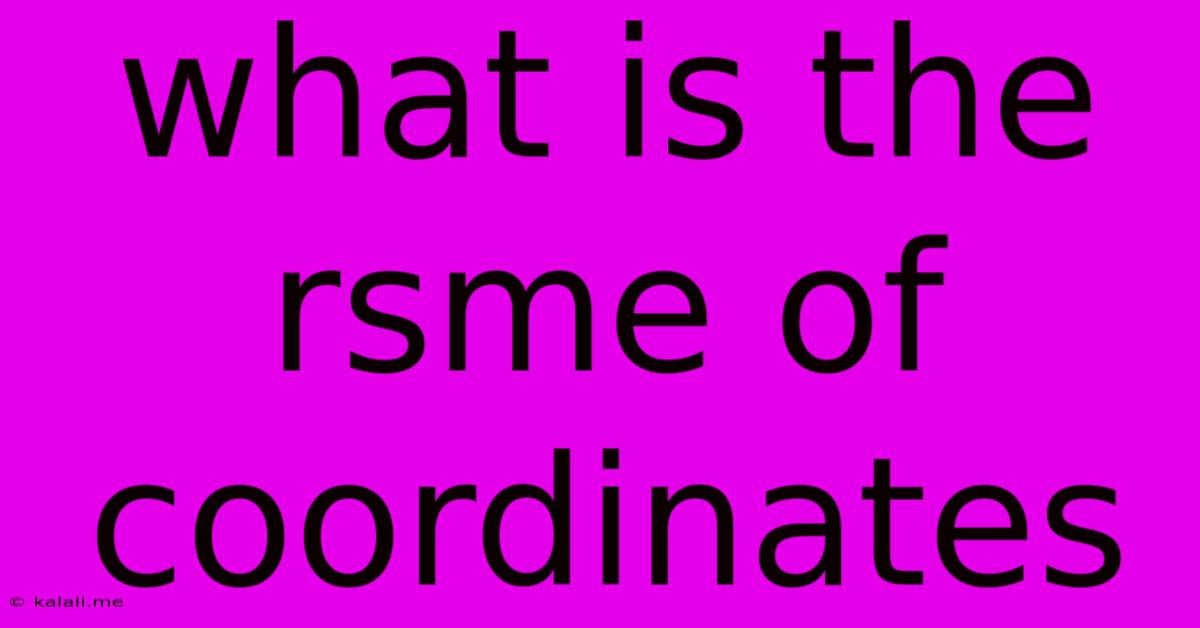What Is The Rsme Of Coordinates
Kalali
May 23, 2025 · 3 min read

Table of Contents
Understanding the RMSE of Coordinates: A Comprehensive Guide
Meta Description: This article explains the Root Mean Square Error (RMSE) of coordinates, its significance in various applications, and how to calculate and interpret it for accurate geospatial analysis. Learn how RMSE helps assess the accuracy of location data.
The Root Mean Square Error (RMSE) is a crucial metric used to evaluate the accuracy of coordinate data. In essence, it quantifies the difference between estimated and actual coordinates, providing a single number representing the average discrepancy. Understanding RMSE is vital in numerous fields, including GIS (Geographic Information Systems), surveying, and GPS technology, where precise location information is paramount.
What is RMSE of Coordinates?
The RMSE of coordinates specifically measures the error in both the X and Y (and sometimes Z) coordinates of a point or a set of points. It's not just about the distance; it considers the error in each dimension separately before combining them to get an overall measure of accuracy. A lower RMSE indicates higher accuracy, meaning the estimated coordinates are closer to the true coordinates. Conversely, a higher RMSE signifies greater inaccuracy and larger deviations from the true locations.
How is RMSE of Coordinates Calculated?
Calculating the RMSE of coordinates involves several steps:
-
Data Acquisition: Gather the true coordinates (reference data) and the estimated coordinates (obtained through a method like GPS, surveying, or modeling). Ensure both datasets have the same number of points and corresponding coordinate pairs (X, Y, and Z if applicable).
-
Difference Calculation: For each point, calculate the difference between the true and estimated coordinates for each dimension (X, Y, and Z). This gives you the error in each dimension for each point.
-
Squaring the Differences: Square each of the individual coordinate errors to remove negative values and emphasize larger errors.
-
Averaging the Squared Differences: Average the squared errors for each dimension across all points.
-
Square Root: Take the square root of the average squared error for each dimension. This provides the RMSE for each coordinate (RMSE<sub>X</sub>, RMSE<sub>Y</sub>, RMSE<sub>Z</sub>).
-
Overall RMSE (Optional): For a single overall RMSE, combine the RMSE values for each dimension, often using the Pythagorean theorem if you have X and Y coordinates (or a similar approach for higher dimensions). This represents the average distance between the true and estimated coordinates. This overall RMSE provides a single, concise summary of the accuracy.
Applications of RMSE in Coordinate Analysis
RMSE finds applications in diverse areas:
- GPS Accuracy Assessment: Evaluating the precision of GPS receivers and comparing different GPS technologies.
- GIS Data Validation: Checking the accuracy of geospatial datasets used in mapping and spatial analysis.
- Remote Sensing: Assessing the accuracy of features extracted from satellite or aerial imagery.
- Surveying and Mapping: Evaluating the accuracy of survey measurements and map production.
- Robotics and Autonomous Navigation: Evaluating the accuracy of robot localization and navigation systems.
Interpreting RMSE Values
The interpretation of RMSE values depends on the context and the units used (meters, feet, etc.). A smaller RMSE indicates better accuracy, while a larger value indicates poorer accuracy. The acceptable RMSE value depends heavily on the application; for high-precision applications, a very low RMSE is needed, while less precision-sensitive applications might tolerate larger values. It's crucial to compare the RMSE to the scale of the project and the requirements for accuracy.
Conclusion
The RMSE of coordinates is a powerful tool for assessing the accuracy of location data. By understanding its calculation and interpretation, researchers and practitioners can effectively evaluate the quality of their geospatial data and make informed decisions in various applications requiring precise location information. Remember to always consider the context and application-specific accuracy requirements when interpreting RMSE values.
Latest Posts
Latest Posts
-
Getting Water Stains Out Of Wood
May 24, 2025
-
How To Throw A Grenade In Fallout 4
May 24, 2025
-
How Long Can Canned Cat Food Sit Out
May 24, 2025
-
Can I Cook Frozen Ground Beef
May 24, 2025
-
I Am The Master Of My Fate
May 24, 2025
Related Post
Thank you for visiting our website which covers about What Is The Rsme Of Coordinates . We hope the information provided has been useful to you. Feel free to contact us if you have any questions or need further assistance. See you next time and don't miss to bookmark.